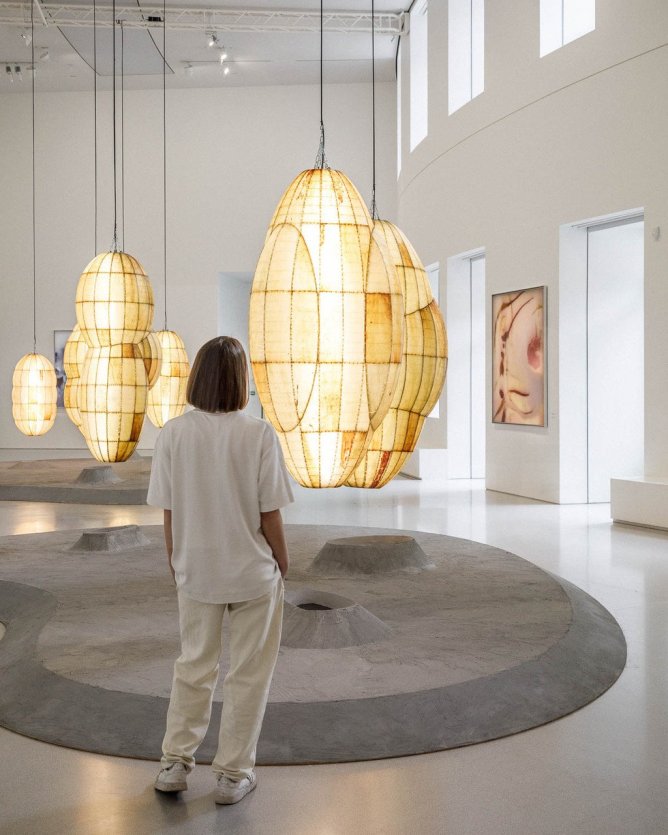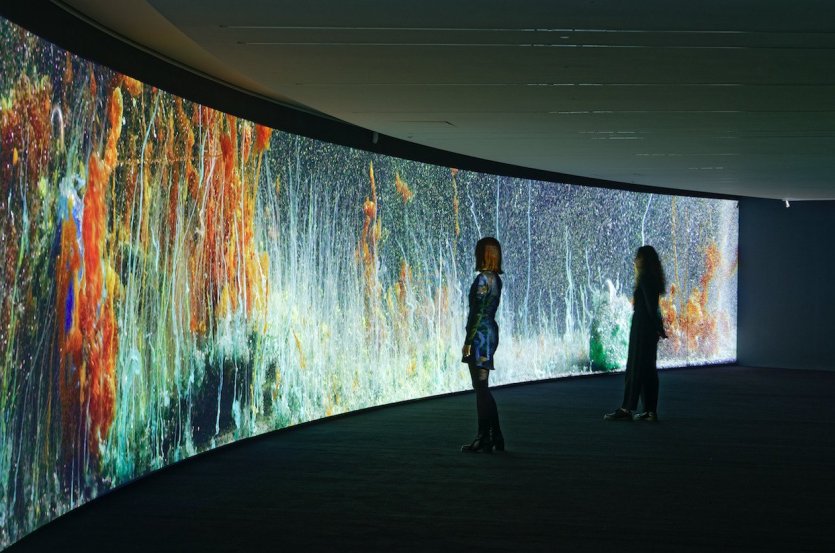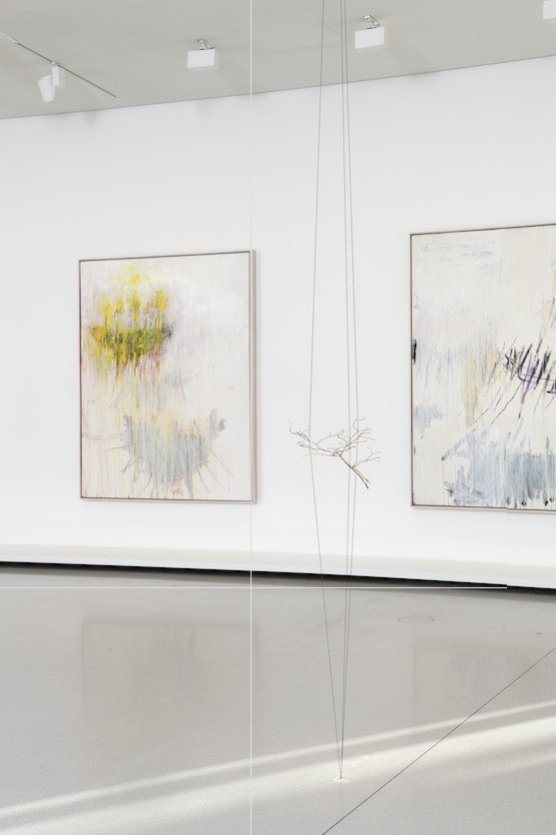
Open since spring 2021, the Bourse de Commerce - Pinault Collection is a new museum of contemporary art located near Les Halles in the 1st arrondissement. This beautiful circular building, whose architecture has been restored and transformed, is the setting for an unprecedented dialogue between heritage and contemporary art. It is here, in the very heart of Paris, that a wide-ranging programme of exhibitions and events offers an insight into the collection of contemporary works that François Pinault has been building up for almost fifty years. An exceptional collection of over 10,000 works - paintings, sculptures, videos, photographs, sound works, installations and performances - by almost 380 artists from all over the world. Once you've taken the time to marvel at the monument's incredible architecture, you shouldn't miss out on discovering its various spaces. At the moment, the new season of exhibitions entitled "Avant l'orage" (Before the storm) is an opportunity to see a number of works that are sure to catch your eye.
The Bourse de Commerce - Pinault Collection, remarkable architecture

Of course, when you arrive at the Bourse de Commerce - Pinault Collection, you can't help but scrutinise every detail of its exterior façade. The building, which is a former grain market, is adorned with Corinthian columns and numerous Renaissance-inspired sculptures. The most surprising thing is yet to come once you get inside. Although the building has been altered several times over the course of its history, its current configuration is remarkable. Its architecture aims to bring together the ancient and the contemporary, and the past and the present. Japanese architect Tadao Ando, genius of minimalism, teamed up with NeM / Niney et Marca Architectes, Pierre-Antoine Gatier and Setec Bâtiment to create the current Museum of Contemporary Art, which will showcase François Pinault's formidable collection.
The imposing concrete cylinder at the heart of the Rotonde, the perfect signature of Tadao Ando, is the first thing that catches the eye. The interior is an exhibition space in its own right. A grand staircase winds around it. It leads to the upper floors and the other exhibition rooms. A walkway also allows you to get up high and take a closer look at the magnificent dome - the first iron and cast-iron cupola from the early 19th century - that lets in the light from the Parisian sky, as well as the huge fresco painted in 1889 at the time of the Universal Exhibition, depicting trade between the continents. Bring your camera!
The Bourse de Commerce - Pinault Collection offers a total of 6,800 m2 of exhibition space, ranging from the intimate to the monumental, with the sublime Rotonde mentioned above. The latter, surrounded by display cases, hosts exhibitions specially designed for it.
The other floors are a succession of exhibition rooms, with the exception of the 3rd floor where the La Halle aux Grains restaurant is located. Everything has been designed to enable visitors to move intuitively from one room to the next. The rooms are bright, with immaculate white throughout. In the basement, the Studio is the space devoted to video and sound works, as well as freer forms. There is also an auditorium, designed to host various cultural events, conferences, screenings and concerts.
A new place in Paris dedicated to contemporary art
With the Bourse de Commerce - Pinault Collection, businessman and patron François Pinault now has a choice setting in the heart of Paris to showcase the incredible collection he has built up. Dedicated to art from the 1960s to the present day, it brings together some 10,000 works, including paintings, sculptures, videos, photographs, sound works, installations and performances, the fruit of the work of artists from all over the world. They represent all generations, with a predilection for emerging trends.
It's worth keeping a close eye on the exhibition programme. The works are presented in the form of temporary exhibitions, as well as exhibitions dedicated to some of the artists in François Pinault's collection and "cartes blanches". Lectures, guided tours, workshops, screenings, concerts and performances will also be regularly scheduled.
At the heart of the Bourse de Commerce - Pinault Collection, visitors are invited to discover the different areas of the museum and their contents. They can approach the display cases, enter the Rotonde bathed in light, take the stairs to get closer to the dome and the fresco, before entering the different rooms. And finally, down to the basement. The works on display invite you to look, to listen and to stimulate all your senses. This is how to discover a collection of contemporary art that is unique in the world, in a place that is just as unique.
5 immersive works to discover at the Bourse de Commerce this summer

From February 2023 until next September, the Bourse de Commerce-Pinault Collection will be presenting a new season of exhibitions entitled "Avant l'orage". It opened with a monumental installation by Danish artist Danh Vo, specially created for La Rotonde. Since the end of May, it has been reactivated with an exhibition dedicated to the British artist Tacita Dean, in La Rotonde and Galerie 2.
With "Avant l'orage", the museum is unveiling new works in its different spaces. Visitors are invited to stroll through the museum's ecosystems as the seasons change. They will discover immersive works and installations linked to nature, an eternal source of inspiration for artists. It's also a great opportunity to reflect on climate change and its consequences, a subject that never fails to nourish their creative spirit. Here are 5 immersive works to discover at the Bourse de Commerce when you visit Paris this summer.
1. Hicham Berrada's hypnotic panorama

Présage, by French-Moroccan artist Hicham Berrada, is a video installation with synchronised video projectors. It immerses viewers in a mutating visual universe. A constant development of shapes, filaments, outgrowths and coloured spores, created by the action of corrosive and toxic substances on metals. A video that, when shown on the scale of the exhibition gallery, introduces the public to a new kind of landscape painting. An unstable surface where shapes and colours are born, reminiscent of the proliferation of a coral reef.
The work, imbued with poetry, is the result of activating the properties of reality. At the heart of the Bourse de Commerce - Pinault Collection, the viewer is plunged into the immensity of a scene whose elements are difficult to grasp. It's up to the viewer to let his or her mind and imagination run wild, to bring out a world of their own.
2. Anicka Yi's cocoons straight out of a science fiction film

Anicka Yi is an American artist of South Korean origin. Her work explores the porosities between the living and the artificial. In "Avant l'orage", visitors will discover incredible luminescent cocoons of algae, in a variety of shapes and suspended over craters. As if floating in space, it's hard to tell whether you're looking at enormous lanterns like those found in Asia, or gigantic pods inside which one or more insects are gestating. You have to get as close as possible to the works to detect the noises and movements of an insect inside. This incredible work explores the interpretive blur between nature and technology, hybridisation and the post-biological mix. As you watch and listen, you enter the heart of a science-fiction film, where plants seem to give birth to electronic beings.
The cocoons are surrounded by paintings from the "ÄLñ§ñ" series, animated by a holographic effect. The artist uses artificial intelligence and elements of mineral origin that act as a layer of paint, reworked in acrylic by Anicka Yi.
3. Cy Twombly's cycle of paintings

The Coronation of Sesostris cycle of paintings comprises ten panels over two metres high. Inspired by the legendary ancient Egyptian king Sesostris, the works evoke alternately glowing suns and flaming ships, references to the running of the pharaoh's sun chariot. The American artist Cy Twombly sets out to depict a mutating solar cycle, in which we pass in turn from sun to night, from the world of the living to the realm of the dead. The life of the king merges with that of the god Ra.
As is customary in Twombly's work, quotations, ancient and contemporary poems are added to the images. Quotations from Sappho, Alcman or a poem by Patricia Waters, the themes addressed are those of the fluctuations of desire and the relationship with lost religions.
4. Robert Gober's suit jacket

While wandering through the museum, visitors may be surprised to come across this black suit jacket, seen from the back, with a white shirt collar protruding from it. Nothing exceptional at first glance. But as they get closer, they notice a small square opening that invites them to look inside. What they discover is a veritable window onto nature, with a mixture of branches, flowing water and rocky walls.
Waterfall, by American sculptor Robert Gober, is a nod to Marcel Duchamp's last installation Étant donnés: 1° la chute d'eau 2° le gaz d'éclairage... In an exhibition entitled "Before the storm", it's hard not to see a reference to climate change. The black jacket evokes businessmen and the abusive exploitation of the planet, with consequences that end up being felt in this lovely bucolic landscape revealed by the small square opening.
5. Tacita Dean's film on old film

Since last May, the Bourse de Commerce - Pinault Collection has been presenting an exhibition of the work of British artist Tacita Dean, featuring previously unseen works and conceived in resonance with the "Avant l'orage" season. One of the highlights is her film Geography Biography (2023), shot in 35mm specially for this exhibition. In this autobiographical cartography, images filmed in various parts of the world are interwoven with twentieth-century postcards from his collection. Together, they give life to recomposed landscapes that evoke distant and imaginary timelines, fragments of the artist's life and memory. As the artist herself says, this film, presented in the form of a diptych, becomes "a very physical manifestation of time: twenty-four images per second. When you work with a physical medium, you are confronted with physical time, far from any hermeticity or discontinuity".


